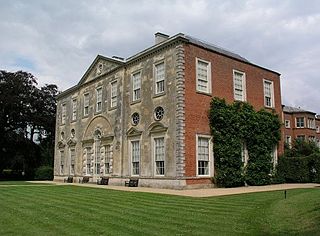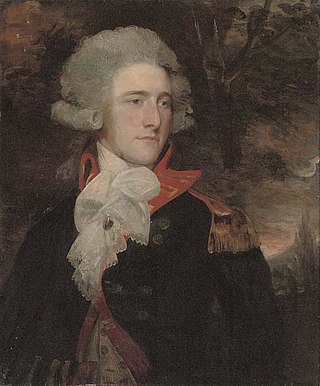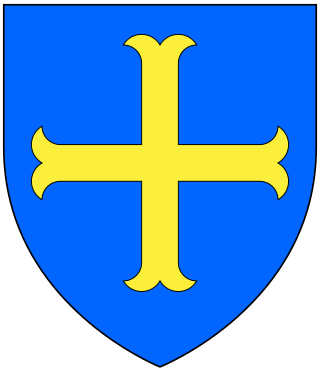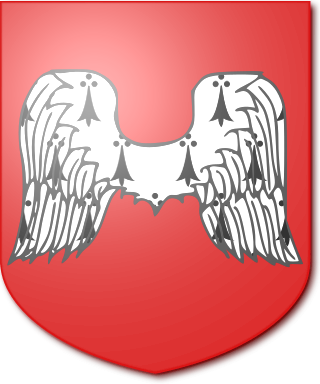
Viscount Cobham is a title in the Peerage of Great Britain that was created in 1718. Owing to its special remainder, the title has passed through several families. Since 1889, it has been held by members of the Lyttelton family.

Earl of Strafford is a title that has been created three times in English and British history.

Earl Rivers was an English title, which has been created three times in the Peerage of England. It was held in succession by the families of Woodville, Darcy and Savage.

Earl Verney, in the Province of Leinster, was a title in the Peerage of Ireland. Sir Ralph Verney sat as a member of parliament for Aylesbury, for Great Bedwyn and for Buckingham. In 1661 he was created a Baronet, of Middle Claydon in the County of Buckingham, in the Baronetage of England. His son Sir John Verney, Bt, was a member of parliament for Buckinghamshire and for Amersham. In 1703, he was raised to the Peerage of Ireland as Baron Verney of Belturbet, in the County of Cavan, and Viscount Fermanagh. His son, the second Viscount, represented Amersham and Wendover in Parliament. In 1742 he was created Earl Verney, in the Province of Leinster, in the Peerage of Ireland. However, all titles became extinct on the death of his son, the second Earl, in 1791.
There have been ten baronetcies created for persons with the surname Browne, six in the Baronetage of Great Britain, three in the Baronetage of Ireland and one in the Baronetage of Nova Scotia. Only one creation is extant as of 2010. Three of the creations were for members of the Browne family headed by the Viscount Montagu.

Viscount Castlecomer was a title created on 15 March 1707, along with the title Baron Wandesford, for Christopher Wandesford, 1st Viscount Castlecomer, whose father, Sir Christopher Wandesford, had been created Baronet of Kirklington, North Yorkshire on 5 August 1662 in the Baronetage of England. The 5th Viscount was created Earl Wandesford on 15 August 1758. All three titles and the baronetcy became extinct on his death in 1784.
Baron Darcy of Chiche was a title in the Peerage of England.
Viscount Wenman, of Tuam in the County of Galway, was a title in the Peerage of Ireland. It was created on 30 July 1628 for Sir Richard Wenman, Member of Parliament for Oxfordshire in 1620 and 1625, the son of Thomas Wenman, a Buckinghamshire landowner. He was made Baron Wenman, of Kilmaynham in the County of Meath, at the same time, also in the Peerage of Ireland. He was succeeded by his son, the second Viscount. He represented Brackley and Oxfordshire in Parliament. On his death the titles passed to his younger brother, the third Viscount. After the death of his childless only son, he obtained a new patent in 1683, with remainder to his great-nephew, Sir Richard Wenman, 2nd Baronet, with the precedence of 1628. The latter succeeded as fourth Viscount according to the new patent in 1686. He had earlier represented Brackley in Parliament. His grandson, the sixth Viscount, represented Oxford in the House of Commons. On the latter's death the titles passed to his son, the seventh Viscount. He sat as Member of Parliament for Oxfordshire for many years. The titles became extinct on his death in 1800. As all the peerage titles were in the Peerage of Ireland, the Viscounts did not have the right to sit in the British House of Lords.

Thomas Henry Liddell, 1st Baron Ravensworth, known as Sir Thomas Liddell, 6th Baronet, from 1791 to 1821, was a British peer and Tory politician.

There have been twenty one baronetcies created for persons with the surname Williams, eight in the Baronetage of England, three in the Baronetage of Great Britain and ten in the Baronetage of the United Kingdom. Only six of the creations are extant as of 2017.

There have been four baronetcies created for persons with the surname Hope, three in the Baronetage of Nova Scotia and one in the Baronetage of the United Kingdom. As of 2010 one creation is extant, one dormant and two extinct.

Elizabeth Savage, Countess Rivers and Viscountess Savage was an English courtier and a Royalist victim of uprisings during the English Civil War.
There have been four baronetcies created for persons with the surname Rich, two in the Baronetage of England, one in the Baronetage of Great Britain and one in the Baronetage of the United Kingdom. As of 2008 three of the creations are extinct while one is dormant.

John Savage, 2nd Earl Rivers was a wealthy English nobleman, politician and Royalist from Cheshire.

There have been two baronetcies created for persons with the surname Yelverton, both in the Baronetage of England.

There have been three baronetcies created for descendants of the ancient Norman family of Molyneux who were granted extensive estates in Lancashire after the Norman Conquest.

There have been three baronetcies, all in the Baronetage of England, created for members of the Spencer family, both for descendants of two younger sons of Sir John Spencer (1524–1586) of Althorp, Northamptonshire.

The Rayney Baronetcy, of Wrotham in the County of Kent, was a title in both the Baronetage of Nova Scotia and the Baronetage of England. It was first created in the Baronetage of Nova Scotia on 19 December 1635 for Sir John Rayney of Wrotham Place, Wrotham, Kent. He was then created a Baronet in the Baronetage of England on 22 January 1642, with the same territorial designation. Rayney's father John Rayney, of West Malling, was a merchant and Alderman of London who bought Wrotham Place which became the family seat. The first Baronet had been knighted at the Coronation of Charles I in 1626. He served as High Sheriff of Kent in 1646. On the death of the fifth Baronet in 1721 the English baronetcy became extinct while the Scottish baronetcy became dormant.
Thomas Darcy, 1st Earl Rivers was an English peer and courtier in the reigns of Elizabeth I, James I and Charles I.

Thomas Savage, 1st Viscount Savage, 2nd Baronet, was an English peer and courtier in the reign of Charles I.
















